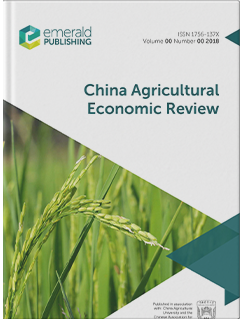农业生产集聚与全要素碳生产率——基于NDDF–MML指数分析
IF 4.6
2区 经济学
Q1 AGRICULTURAL ECONOMICS & POLICY
引用次数: 12
摘要
农业碳生产力考虑了“农业经济增长”和“碳减排”的双重目标。提高农业碳生产率是推进农业绿色低碳发展的必然要求。农业生产集聚在世界范围内普遍存在,但农业生产集聚与农业碳生产率之间的关系尚无定论。本文旨在研究农业生产集聚对农业碳生产率的影响,有助于更好地理解集聚、农业经济发展和碳排放之间的关系,更好地规划农业布局,构建现代农业产业体系,实现碳调峰和碳中和的目标。基于1991 - 2019年中国省际数据,采用非径向定向距离函数(NDDF)和metfrontier Malmquist-Luenberger (MML)生产率指数对全要素农业碳生产率进行测度。随后,采用面板双向固定效应模型研究农业生产集聚对农业碳生产率的影响及其机理,并采用两阶段最小二乘法(IV-2SLS)求解内生性问题。最后,本文从农业物质资本投入效率的角度构建了一个调节效应模型。实证结果表明,中国省级农业碳生产率总体呈增长趋势,农业技术进步是增长的主要来源。农业生产集聚与农业碳生产率呈倒u型关系。农膜投入效率、农机投入效率和水资源投入效率对二者之间的倒u型关系具有调节作用。农业生产集聚除了影响农业投入要素外,还通过抑制农业碳排放来促进农业碳生产率,其内在机制是农业绿色技术进步和农村人力资本改善。创新性/价值本文创新性地采用NDDF-MML方法,更加科学、准确地测度了农业全要素碳生产率,解决了以往研究忽视群体异质性的问题和传统生产率测度的不足。本文还从理论和实证两方面解释了农业生产集聚与农业碳生产率之间的倒u型关系。进一步,从农业物质资本投入效率的角度,探讨了化肥、农药、农膜、农机和水资源投入效率对农业生产集聚影响农业碳生产率的调节作用,回答了农业生产集聚碳减排的机制。本文章由计算机程序翻译,如有差异,请以英文原文为准。
Agricultural production agglomeration and total factor carbon productivity: based on NDDF–MML index analysis
PurposeAgricultural carbon productivity considers the dual goals of “agricultural economic growth” and “carbon emission reduction”. Improving agricultural carbon productivity is a requirement for promoting green and low-carbon development of agriculture. Agricultural production agglomeration is widespread worldwide, but the relationship between agricultural production agglomeration and agricultural carbon productivity is inconclusive. This paper aims to study the impact of agricultural production agglomeration on agricultural carbon productivity, which is conducive to a better understanding of the relationships among agglomeration, agricultural economic development and carbon emission, better planning of agricultural layout to build a modern agricultural industrial system and achieve the goal of carbon peaking and carbon neutrality.Design/methodology/approachBased on China's provincial data from 1991 to 2019, this paper uses non-radial directional distance function (NDDF) and Metafrontier Malmquist–Luenberger (MML) productivity index to measure total factor agricultural carbon productivity. Subsequently, using a panel two-way fixed effect model to study the effect and mechanism of agricultural production agglomeration on agricultural carbon productivity, and the two-stage least squares method (IV-2SLS) is used to solve endogeneity. Finally, this paper formulates a moderating effect model from the perspective of the efficiency of agricultural material capital inputs.FindingsThe empirical results identify that Chinese provincial agricultural carbon productivity has an overall growth trend and agricultural technological progress is the major source of growth. There is an inverted U-shaped relationship between agricultural production agglomeration and agricultural carbon productivity. The input efficiency of agricultural film, machine and water resources have moderating effects on the inverted U-shaped relationship. Agricultural production agglomeration also promotes agricultural carbon productivity by inhibiting agricultural carbon emissions in addition to affecting agricultural input factors and its internal mechanisms are agricultural green technology progress and rural human capital improvement.Originality/valueThis paper innovatively adopts the NDDF–MML method to measure the total factor agricultural carbon productivity more scientifically and accurately and solves the problems of ignoring group heterogeneity and the shortcomings of traditional productivity measurement in previous studies. This paper also explains the inverted U-shaped relationship between agricultural production agglomeration and agricultural carbon productivity theoretically and empirically. Furthermore, from the perspective of agricultural material capital input efficiency, this paper discusses the moderating effect of input efficiency of fertilizers, pesticides, agricultural film, agricultural machines and water resources on agricultural production agglomeration affecting agricultural carbon productivity and answers the mechanism of carbon emission reduction of agricultural production agglomeration.
求助全文
通过发布文献求助,成功后即可免费获取论文全文。
去求助
来源期刊

China Agricultural Economic Review
AGRICULTURAL ECONOMICS & POLICY-
CiteScore
9.80
自引率
5.90%
发文量
41
审稿时长
>12 weeks
期刊介绍:
Published in association with China Agricultural University and the Chinese Association for Agricultural Economics, China Agricultural Economic Review publishes academic writings by international scholars, and particularly encourages empirical work that can be replicated and extended by others; and research articles that employ econometric and statistical hypothesis testing, optimization and simulation models. The journal aims to publish research which can be applied to China’s agricultural and rural policy-making process, the development of the agricultural economics discipline and to developing countries hoping to learn from China’s agricultural and rural development.
 求助内容:
求助内容: 应助结果提醒方式:
应助结果提醒方式:


